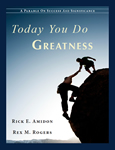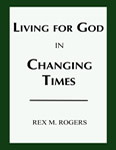Has it occurred to you that the music you hear today in church is not the music that churchgoers heard a millennium ago, or a century ago, or maybe a few decades ago when you were a kid?
Hi, I’m Rex Rogers and this is episode #199 of Discerning What Is Best, a podcast applying unchanging biblical principles in a rapidly changing world, and a Christian worldview to current issues and everyday life.
Throughout Scripture there are hundreds of references to music, instruments, praise, singing, dance, or a joyful noise.
Some specific examples include: "Praise him with the sounding of the trumpet, praise him with the harp and lyre, praise him with timbrel and dancing, praise him with the strings and pipe, praise him with the clash of cymbals, praise him with resounding cymbals. Let everything that has breath praise the Lord. Praise the Lord!" Ps 150:3-6
"Speaking to one another with psalms, hymns, and songs from the Spirit. Sing and make music from your heart to the Lord." Eph 5:19
"Let the message of Christ dwell among you richly as you teach and admonish one another with all wisdom through psalms, hymns, and songs from the Spirit, singing to God with gratitude in your hearts." Col 3:16
"The trumpeters and musicians joined in unison to give praise and thanks to the Lord. Accompanied by trumpets, cymbals and other instruments, they raised their voices in praise to the Lord and sang: 'He is good; his love endures forever.' Then the temple of the Lord was filled with the cloud of God’s glory." 2 Chron 5:13-14
“Like any of God's gifts, music can be used for good or used for bad; it can be used in holy ways or in unholy ways; it can be a power for virtue or for vice.”
God's people in both the Old and New Testaments played musical instruments and sang in a variety of ways so that God would be praise.
Types of music, types of instruments and whether or how they are used, and the themes or focus of music in the church has varied throughout the history of the Church. And various Christian tug-o-wars if not outright battles over music have occurred throughout the history of the Church.
“Early centuries church music was quite simple, probably following some of the practices of the Jewish synagogues. Psalms were mainly sung; perhaps a few early Christian hymns and ‘spiritual songs’ outlining the basic beliefs about Jesus were added later.”
How the applications of music in the Church have progressed throughout the history of the Church is fascinating, and as I said, almost always with disagreement or controversy.
During the Early Church centuries, acapella, and “plain chanting,” were prominent. Christians sang during worship services but used no instruments. Most church fathers saw the use of instruments in worship as a ‘childish’ weakness and saw it as less glorifying to God that words of praise.
From the 1st to 4th Centuries, antiphonic hymns with its call-and-response technique, began to be used. Often the verses were Psalm singing or short, sung sentences such as ‘Lord, have mercy’ and ‘We lift up our hearts.’” Such call and response continues today in various church liturgies.
During the 5th – 9th Centuries, the Gregorian Chant became popular. This is a form of monophonic sound, meaning a single melodic line sang without accompaniment. These tranquil yet profound melodies designed to enhance the spiritual experience.
As Protestantism emerged during the Reformation, congregational singing became more important as a means of expressing faith together. Exclusive use of Latin gave way to the vernacular languages in part due to the work of the Reformers who wanted to be not-Catholic if not anti-Catholic in their practices.
By the 9th to 12th Centuries, polyphonic music made its way into the Church. This is two or more simultaneous lines of independent melody that we would recognize today. Harmony emerged, layers of complexity with multiple voices singing together.
Organs were, like all instruments, initially banned, then gradually they were introduced and integrated, eventually becoming synonymous with church and sacred music. Some of the greatest church music ever written and presented was played on enormous, rich, and complex pipe organs in European cathedrals.
In America, for a time organs dominated the church music scene, but the instruments were heavier, more expensive, and in some sense more challenging to learn to play than pianos. And ironically, as organs faded from church, for a time, their music found new expression in roller skating rinks, or even in rock and roll.
Today, organs have all but disappeared from church worship services. And the number of people who can actually play an organ has dwindled to a handful. In fact, if you really want to hear big-sound organs, you’ll need to go to a major league baseball park or perhaps a hockey arena.
Great Reformer John Calvin (1509-1564) saw the church separate from society, so he wanted congregational singing limited to words of Scripture.
Great Reformer Martin Luther (1483-1546) saw the church as part of society, so he rejected formalism, urged use of vernacular, melodies, chorales of the people.
Protestant denominations, by definition being different and new and other compared to the institution of the Roman Catholic Church, tended to embrace distinct musical styles, often reflective of their doctrinal emphasis and cultural context.
To get a feel for how people in the Middle Ages struggled with the place and appropriateness of music and musical instruments in the church, consider this dictum from Pope Benedict XIV (d. 1758), who declared that "ecclesiastical music must be composed in a style which differs from that of the theatre. The solo, the duet, the trio, are forbidden. While the organ was "acceptable" and stringed instruments "tolerated," the "forbidden instruments included timpani, trumpets, oboes, flutes, mandolins" and "in general, all instruments which are theatrical in character."
This illustrates how seriously the Church took the issue of music and worship and how it struggled with what God would consider worshipful and what God would bless.
What we know as the hymn movement flourished in the 16th-19th Centuries with composers like Isaac Watts (“When I Survey the Wondrous Cross”) and Charles Wesley (“O for a Thousand Tongues to Sing”) shaping Protestant worship.
The Second Great Awakening – 18th-19th C – gave rise of Gospel music, with its simple, emotional melodies aimed at evangelism, e.g., Fanny Crosby, “Blessed Assurance.” This vigorous and healthy spiritual movement continued to influence church music throughout the 19th Century, adding revival songs to church repertoires.
By the 20th-21st Centuries, praise bands, contemporary worship, and diverse musical styles made their presence known in the church – even country, pop, rock and roll, jazz, and hip hop – setting up what’s come to be called the “Worship Wars,” conflict in the church between so-called traditional and so-called contemporary worship preferences.
Disputes centered around use of Contemporary Christian Music, featuring lyrics not necessarily featuring Scripture and energetic music styles involving a lot of physical movement whether or not dance was involved, as opposed to, for example, classic hymns. Interpretive dance arrived in churches too.
In the midst of this, churchgoers debated whether guitars, keyboards, and drums should be used in church, and should special lighting effects and other theatrical or “stage effects” be used? One of my sons as a teenager played drums in church and came home to say, “Dad, when I’m up there playing drums, the old people frown at me.” I joked with him that the Plexiglas sound barriers around a drum set was actually protective bullet proof glass.
But seriously, remember the pope worrying about similar things back in the 1700s We’re still fussing about music in the church.
Today, it seems that most churches, even denominations, develop a list of favorite worship songs they use in their services. There is nothing necessarily wrong with this because the choices are generally rooted in that church or denomination’s doctrine, traditions, preferences, and perhaps ethnic, national, or linguistic heritage and culture.
But I’ve also wondered whether some intentional exposure to church music developed at other times in church history might broaden our appreciation for the diversity and quality of music in the history of Christianity and may even deepen our understanding of the richness of this history.
Maybe we could meditate on these thoughts for a while:
- The Bible does not dictate one type of music, instrument, or mode of singing.
- It is OK to have preferences, just not elevate your preference to holy.
- We should learn to appreciate different types of Christian music.
Well, we’ll see you again soon. This podcast is about Discerning What Is Best. If you find this thought-provoking and helpful, follow us on your favorite podcast platform. Download an episode for your friends. For more Christian commentary, check my website, r-e-x-m as in Martin, that’s rexmrogers.com. Or check my YouTube channel @DrRexRogers for more podcasts and video.
And remember, it is for freedom that Christ has set us free. Stand firm.
© Rex M. Rogers – All Rights Reserved, 2025
*This podcast blog may be reproduced in whole or in part with a full attribution statement. Contact me or read more commentary on current issues and events at www.rexmrogers.com/ or my YouTube channel @DrRexRogers, or connect with me at www.linkedin.com/in/rexmrogers or https://x.com/RexMRogers.


